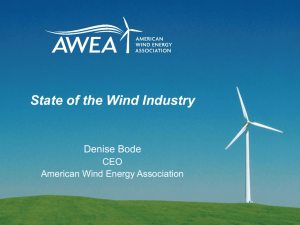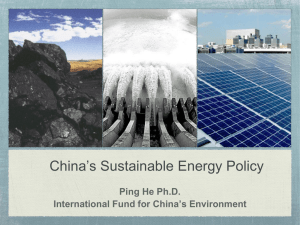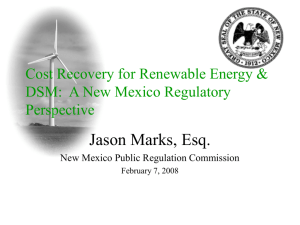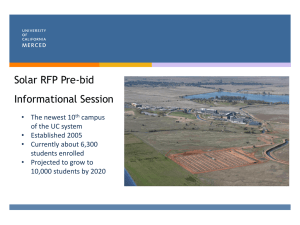US energy today
advertisement
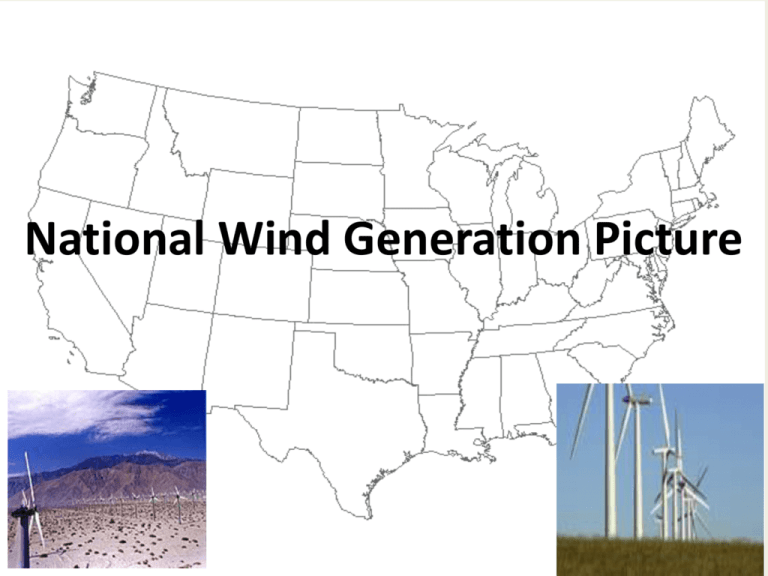
National Wind Generation Picture Outline 1. 2. 3. 4. 5. US energy today Legislative landscape The future Long-term national planning Conclusions 1. US energy today: Existing US resource mix by capacity 3 Source: AWEA 2009 Annual Wind Report 1. US energy today: Retail Prices - 2007 4 1. US energy today: US wind capacity historical growth 5 Source: AWEA 2009 Annual Wind Report 1. US energy today: Wind capacity by state 6 Source: AWEA Website: www.awea.org 1. US energy today: Wind capacity and 2008 growth by state State In construction Rank by Capacity Texas 1,096 1 Illinois 703 10 Indiana 505 14 Oregon 426 6 Iowa 409 2 Washington 405 5 Pennsylvania 356 16 North Dakota 345 13 Wyoming 269 12 Utah 204 29 Oklahoma 200 11 Colorado 174 8 Missouri 150 19 Montana 104 21 West Virginia 101 18 New Mexico 100 15 Maine 92 25 Arizona 63 37 Nebraska 42 22 Minnesota 40 47 State Texas Iowa California Minnesota Washington Oregon New York Colorado Kansas Illinois Oklahoma Wyoming North Dakota Indiana New Mexico Pennsylvania Wisconsin West Virginia Missouri South Dakota Existing 8,361 3,043 2,787 ? 1,805 ? 1,575 1,408 1,264 ? 1,068 1,014 ? 915 831 816 ? 714 531 497 463 449 ? 330 309 288 Source: AWEA Website: www.awea.org 1. US energy today: Wind % capacity by state 8 Source: AWEA 2009 Annual Wind Report 1. US energy today: Market share of total US wind fleet 9 Source: AWEA 2009 Annual Wind Report 1. US energy today: Market share of 2008 wind installations 10 Source: AWEA 2009 Annual Wind Report 1. US energy today: Ownership by company and by utility 11 Source: AWEA 2009 Annual Wind Report 1. US energy today: Power purchase agreements+ownership 12 Source: AWEA 2009 Annual Wind Report 1. US energy today: Wind plant size 13 Source: AWEA 2009 Annual Wind Report 2. Legislative landscape: Renewable portfolio standards (on energy) 29 states, differing in % (10-40), timing (latest is 2030), eligible technologies/resources (all include wind) WA: 15% by 2020* MN: 25% by 2025 MT: 15% by 2015 ☼ OR: 25% by 2025 (large utilities)* 5% - 10% by 2025 (smaller utilities) VT: (1) RE meets any increase in retail sales by 2012; (2) 20% RE & CHP by 2017 (Xcel: 30% by 2020) MI: 10% + 1,100 MW ND: 10% by 2015 WI: Varies by utility; 10% by 2015 goal ☼ NV: 25% by 2025* ☼ CO: 20% by 2020 IA: 105 MW (IOUs) 10% by 2020 (co-ops & large munis)* CA: 33% by 2020 UT: 20% by 2025* KS: 20% by 2020 (Class I Renewables) RI: 16% by 2020 CT: 23% by 2020 ☼ OH: 25% by 2025† ☼ PA: 18% by 2020† WV: 25% by 2025*† ☼ NJ: 22.5% by 2021 VA: 15% by 2025* ☼ MD: 20% by 2022 ☼ MO: 15% by 2021 ☼ AZ: 15% by 2025 ☼ DE: 20% by 2019* ☼ NC: 12.5% by 2021 (IOUs) ☼ DC: 20% by 2020 10% by 2018 (co-ops & munis) ☼ NM: 20% by 2020 (IOUs) ☼ NH: 23.8% by 2025 + 1% annual increase ☼ NY: 24% by 2013 ☼ IL: 25% by 2025 New RE: 10% by 2017 ☼ MA: 15% by 2020 by 2015* SD: 10% by 2015 ME: 30% by 2000 10% by 2020 (co-ops) TX: 5,880 MW by 2015 HI: 40% by 2030 29 states & DC have an RPS State renewable portfolio standard State renewable portfolio goal Solar water heating eligible ☼ Minimum solar or customer-sited requirement *† 6 states have goals Extra credit for solar or customer-sited renewables Includes non-renewable alternative resources 14 2. Legislative landscape: Tax incentives • Federal Incentives: • Renewed incentives Feb 2009 through 12/31/12, via ARRA • 2.1 cents per kilowatt-hour PTC,or 30% investment tax credit (ITC) • State incentives: • IA: 1.5¢/kWhr, small wind, Utah, Oklahoma, 15 • Various other including sales & property tax reductions 2. Legislative landscape: Federal, congressional bills Waxman-Markey (House, passed) Kerry-Boxer (Senate) 2012 renewables target 6% of electric energy renewable 2020 renewables target 20% 2012 emissions target Cuts by 3% (2005 baseline) 2020 Emissions target Cuts by 17% Cuts by 20% (2005 baseline) 2030 Emissions target 42% 42% 2050 Emissions target 83% 83% In separate bill (Bingaman) See http://www.grist.org/article/2009-06-03-waxman-markey-bill-breakdown/ 16 2. Legislative Landscape Building Transmission $60 billion AEP plan Joint Coordinated System Plan (20%wind). Cost: $82 billion (2024 $) 17 2. Legislative Landscape Building Transmission •Multi-state transmission is very difficult • FERC’s authority – national interest corridors • Regional efforts • 2008: Uppr Mdwst Trns Dvlpmnt Initiative: MN,ND,SD,IA,WI • 2008: Joint Coord Sys Planning: MISO, PJM, SPP, TVA, MAPP • 2010: DOE transmission planning grants: Eastern Interconnection Planning Collaborative: PJM, NYISO, ISO-NE, MISO, SoCo, TVA, MAPP, Entergy WECC: Most of the western companies • Will FERC mandate if a state rejects T-plans? 18 3. The future: US wind potential by state Annual wind energy potential (1012 w-hrs) R= Annual wind energy potential -----------------------------------------2006 state annual retail sales States with high production and R-ratio have high export potential (Montana, Dakotas, Wyoming, Nebraska, Kansas) Analysis assumes (a) only sites having capacity factor > 20% included; (a) loss of 20% and 10% of potential power for onshore and offshore, respectively, caused by interturbine interference, (c) offshore siting distance within 50 nm (92.6 km) of nearest shoreline. 19 Source: Xi Lua, M. McElroya, and J. Kiviluomac, “Global potential for wind-generated electricity,” Proc. of the National Academy of Sciences, 2009, www.pnas.orgcgidoi10.1073pnas.0904101106. 3. The future: US wind potential Contiguous US annual wind energy potential , 1015 wh Multiples of 2008 Total US Energy Consumption* Onshore 62 2.12 Offshore, 0-20 meter 1.2 .041 Offshore, 20-50 m 2.1 .072 Offshore, 50-200 m 2.2 .075 Total 68 2.321 •Total 2008 US Energy consumption across all sectors is 100 Quads: 100Q 1E15BTU kwh 1000wh 29.3E15wh Q 3413BTU kwh 20 Source: Xi Lua, M. McElroya, and J. Kiviluomac, “Global potential for wind-generated electricity,” Proc. of the National Academy of Sciences, 2009, www.pnas.orgcgidoi10.1073pnas.0904101106. Long-term national planning: How wind fits in Energy system: Electric, Fuels, Transportation LIQUID FUEL NATURAL GAS Washington Montana New Hampshire Maine Minnesota North Dakota Oregon Vermont Wisconsin Massachusetts Idaho New York Michigan South Dakota Wyoming Rhode Island Nebraska Pennsylvania Iowa Utah Indiana Delaware Ohio Illinois Nevada West Virginia Maryland Virginia Colorado Kansas California Missouri Kentucky Arizona North Carolina Tennessee Oklahoma South Carolina Arkansas New Mexico Georgia Alabama Mississippi Legend Louisiana Interstate Pipelines Texas Intrastate Pipelines Florida ELECTRIC RAIL AIR 22 Interstate Connecticut New Jersey Energy system: Today 23 US ENERGY USE IS 69% ELECTRIC & TRANSPORTATION GREENING ELECTRIC & TRANSPORTATION ENERGY SOLVES THE EMISSIONS PROBLEM US CO2 EMISSIONS IS 74% ELECTRIC & TRANSPORTATION Energy system: Today Solar, 0.09 Nuclear, 8.45 Hydro, 2.45 8.45 6.82 20.54 Electric Generation 39.97 12.68 27.39 Wind, 0.51 Unused Energy (Losses) 57.07 Residential 11.48 Geothermal 0.35 Natural Gas 23.84 Commercial 8.58 Coal 22.42 Industrial 23.94 8.58 Used Energy 42.15 20.9 Biomass 3.88 26.33 Petroleum 37.13 24 LightDuty: 17.12Q Freight: 7.55Q Aviation: 3.19Q Transportation 27.86 6.95 Energy System: Transport goes electric! A modified French high-speed train has set a new world speed record for a train on conventional rails of 357 mph. Warren Buffet's MidAmerican Energy Holdings bought 9.9% of BYD for $232 million. World's first all-electric locomotive has over 1,000 batteries, runs 24 hours on a single charge. A possible future Solar, 1.0 Nuclear, 15 Hydro, 2.95 15 INCREASE Non-CO2 6.82 12Q to 30Q 20.54 Electric Generation 49.72 12.68 25.7 Wind, 8.1 Residential 11.48 Geothermal 3.04 Commercial 8.58 Natural Gas 23.84 Used Energy 42.15 IGCC, 3 Old Coal 10.42 8.58 Industrial 23.94 8.5 Biomass 3.88 Petroleum 15.13 26 Unused Energy (Losses) 43.0 26.33 REDUCE PETROLEUM 37Q15Q LightDuty: Freight: Aviation: 8.56Q 3.75Q 3.19Q Transportation 15.5 6.95 Infrastructure planning: Environmental Impacts 22Quads Petroleum reduction×156.4lbs/MBTU*0.4535 =1560 MMT CO2 12Q Old Coal reduction×212.7lbs/MBTU*0.4535 =1157 MMT CO2 ----------------------------------------------------------------------------------------------------------- TOTAL CO2 REDUCTION= 2717 MMT CO2 2717 100% 37.3% 7282 Total US 2007 GHG If we achieve this worldwide by 2035, there is a 75% chance of not exceeding the 2 degree guardrail. 27 Infrastructure planning: Unit Costs Technology Overnight cost $/kW Prod cost $/MWhr (Fuel costs + environmental cost*) Solar thermal 5021 0 Solar PV 6038 0 Nuclear 3318 2.00 Wind onshore 1923 0 Wind offshore 3851 0 Geothermal 4000 0 Coal conventional 2058 2.95 Clean coal (IGCC+seq) 3500 4.50 *Environmental cost s assumed to be $1.5/MWhr, for nuclear, $3/MWhr 28 for conventional coal, and $1.5/MWhr for clean coal. Infrastructure planning: Solution Cost Technology Additional capacity, GW Overnight cost Change in annual fuel cost Solar thermal 65.5 0.329 0 Solar PV 58.9 0.356 0 Nuclear 60.9 0.202 +0.0038 Wind onshore 630 1.211 0 Wind offshore 80 0.307 0 Geothermal 106 0.181 0 Reduced 0 -0.0053 29.5 0.103 +0.0010 - 1.0 -0.264 1031 3.7 -0.264 Coal conventional Clean coal (IGCC+seq) Elec. Transprt. TOTALS 29 Trillion dollars Infrastructure planning: Solution explanation Internal combustion engines Coal-fired power plants Why do we reduce production cost and emissions? Because we reduced the use of combustion! 30 Infrastructure planning: more questions SOLAR CLEAN-FOSSIL GEOTHERMAL Where, when, & how to interconnect? BIOMASS NUCLEAR 31 Wind Conclusions 1. Wind resource not large player today. 2. Legislative landscape intent on changing that. 3. US wind energy potential: could supply 2ב08 total (100Q) energy consumption. 4. Wind must be a major player in economic solutions to global warming. 5. 710 GW of wind by 2035, plus a little of all other non-CO2 resources, represents US contribution towards a feasible solution to global warming. 32

